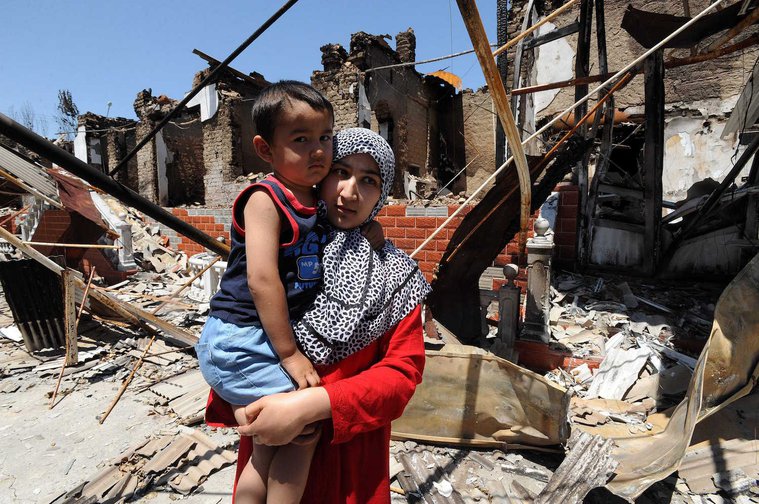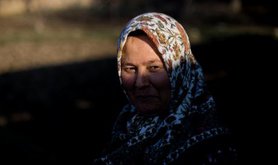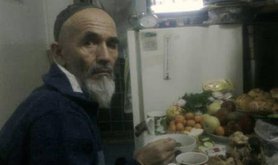
A decade on, what has been learnt from Kyrgyzstan's 2010 clashes?
If ordinary people improve the prospects for dialogue, they can deescalate violence at critical times. That's how they can ensure that history does not repeat itself.

Ten years ago today, on 10 June 2010, what seemingly started as a nighttime brawl between Kyrgyz and Uzbek youths at a casino in southern Kyrgyzstan escalated into violent clashes. It quickly spread.
The violence rapidly engulfed other cities in this ethnically mixed area of the country, such as Osh and Jalal-Abad. The most reliable estimates speak of 500 killed, several thousand injured, and 400,000 displaced, including 100,000 refugees who fled into neighbouring Uzbekistan. Approximately 2,000 properties were destroyed. By the scale and speed of destruction, this was the deadliest communal conflict since Kyrgyzstan's independence in 1991. It remains so to this day.
By the scale and speed of destruction, this was the deadliest communal conflict since Kyrgyzstan's independence. It remains so to this day.
We’ve got a newsletter for everyone
Whatever you’re interested in, there’s a free openDemocracy newsletter for you.
The country appeared to be descending into a full-scale civil war, yet it did not. Largely, this wasn’t thanks to the authorities. In fact, the actions of the law enforcement agencies at times contributed to fanning the flames of conflict. In several cases, the military unjustifiably removed barricades erected by residents of various neighbourhoods without taking further measures to protect them. On some occasions, when raging crowds of assaulted military barracks, the armed forces offered little resistance, allowing them to take possession of APCs, firearms, and ammunition that were later used in the conflict.
Most analyses of what became known as the 2010 Osh ‘events’ focused on the broader picture, such as power struggles among politicians and regional elites, economic inequality, grievances between ethnic groups, and the uneven social and economic development between the country’s north and south. These factors provide an insight into the context in which the violence flared up, but fewer experts have asked why so many towns and villages with mixed Kyrgyz and Uzbek populations were largely spared from the conflict.
As the largest cities in southern Kyrgyzstan, it can be argued that Osh and Jalal-Abad were the natural focal points for communal violence and ethnic mobilisation. But what we observed on the ground was that, even in these cities, violence spread unevenly across various neighbourhoods, leaving many areas safe despite the intensity and brutality of the conflict raging around them. These safe havens existed thanks to the actions of local communities. Locals thereby played a key role in deescalating the situation, when the central government and law enforcement were either completely paralysed, unable or unwilling to intervene, or even complicit in the violence.
The conflict broke out only two months after a popular uprising had deposed President Kurmanbek Bakiyev on 7 April 2010, bringing to power a loose coalition of politicians from the opposition in the form of the Interim Government (IG). In the ensuing power vacuum, the IG could only exercise firm control over the capital Bishkek and other northern areas. With the breakdown of formal state institutions, local communities came to determine the course of the conflict.
Given the existing chessboard-like segregation of the cities of Osh and Jalal-Abad, the outbreak of violence turned whole neighbourhoods into ethnic enclaves. Residents erected barricades and roadblocks for self-defence. These neighbourhoods were temporarily transformed into self-governing units where the authority of informal community leaders took the place of the government in addressing the raging violence. They faced the unenviable task of urging their communities to exercise restraint, while trying to dispel fear and mistrust. Many such leaders and activists negotiated non-aggression pacts with other local communities, thus sparing their own from the violence and preventing the escalation to civil war. This is confirmed by the fact that neighbourhoods with weak inter-communal ties and local leaders with low standing among residents were overwhelmed by violence, due to their insufficient organisational capacity and weak norms of reciprocity.

Once the violence subsided, conspiracy theories quickly became common currency among local residents to explain the causes of the conflict. In our exchanges, we frequently heard locals claiming that the ‘other side’ had been preparing for violence, implying that the ‘events’ had been premeditated. One Kyrgyz community head in a neighbourhood in Jalal-Abad, for example, who had generally had good working relations with Uzbeks, told one of the authors that the Uzbek community was aware of preparations for violence because, according to him, many had left their homes before riots erupted in the city. Likewise, a prominent Uzbek human rights activist in Osh alleged that Kyrgyz electricians, who served his and other Uzbek neighborhoods, were actually compiling secret lists of Uzbek houses to be later handed over to their Kyrgyz attackers.
These and other similar stories show how, in the aftermath of the conflict, relations between Kyrgyz and Uzbeks continued being dominated by fear and mistrust, a situation that obtains to this day. Many people living in mixed neighborhoods where the other community was dominant have since moved to quarters where their own community is prevalent, resulting in further ethnic segregation, particularly in Osh. During the time we spent in Osh, Jalalabad and other towns, we never witnesses ethnically mixed groups of youths socialising. The absence of these everyday contacts between ordinary Uzbeks and Kyrgyz was one important reason why residents of the two communities couldn’t effectively communicate with each other to diffuse the tension. This is still the case as both communities live parallel lives, only occasionally coming into contact during their brief transactions in the bazaars and few other common spaces.
This is what makes the role of a few communal leaders and ethnic mediators so central. In the Uzgen district, for example, local Kyrgyz and Uzbek communal leaders, in close collaboration with the chief of police, managed to work through their fears and prevent violence. That Uzgen – a hotbed of violence during a previous conflict in 1990, during the twilight years of the Soviet Union – managed to keep the peace in 2010 was remarkable. It also presented a big puzzle for those who failed to identify the crucial role played by community leaders and activists. When the state cannot fulfill its responsibility to protect citizens, community leaders can fill the void by relying on their informal authority.
There is a downside to this, too. In a highly segregated context, this can reinforce the monopolisation of intergroup contacts by community leaders, eventually leading to further dependence upon them and possibly incentivises abuse of power. Meanwhile, Kyrgyzstan's politicians have tried to court or manipulate such neighbourhood-level leaders for their personal political interests. When that didn't work, politicians have also resorted to threats. For instance, a Uzbek community leader admitted to us that he had been threatened by local politicians to ensure that his community voted for specific political parties and party candidates during elections. Furthermore, Kyrgyz political entrepreneurs have instrumentalised the ‘events’ by making inflammatory remarks against the Uzbek community in an attempt to galvanise their bases and win votes, resulting in a further increase in communal tensions.
What we witnessed in southern Kyrgyzstan demonstrates that activists and ordinary citizens can deescalate violence at critical times.
In the end, this rising ethnic segregation and mistrust between Kyrgyz and Uzbeks is due to a general lack of security. What's needed is government and the international promotion for initiatives that aim to restore, mend, and reinforce ties between communities and reduce communal segregation. What's needed are civic organisations, clubs and associations which could enhance intercommunal communication and foster desegregation. What's needed are measures aimed at improving the organisational capacity of local neighborhoods and communities, making them less reliant on specific leaders and activists and more resilient in their shared lived experience.
Fortunately, we haven’t seen a repeat of the ‘events’ in the past decade. However, many problems at the heart of this conflict still persist. Arguably some have even worsened, as is the case with increasing segregation. What we witnessed in southern Kyrgyzstan demonstrates that, by building community resilience through channels for dialogue between leaders, activists and ordinary citizens can deescalate violence at critical times.
In short, history doesn't need to repeat itself.
Read more
Get our weekly email




Comments
We encourage anyone to comment, please consult the oD commenting guidelines if you have any questions.